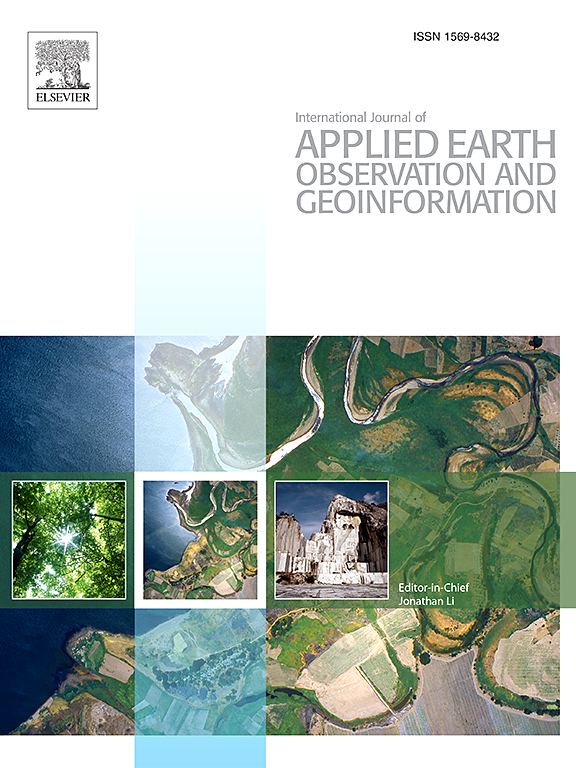利用物候排列的植被指数异常改善作物状况监测-以爱荷华州中部为例
IF 7.6
Q1 REMOTE SENSING
International journal of applied earth observation and geoinformation : ITC journal
Pub Date : 2025-04-11
DOI:10.1016/j.jag.2025.104526
引用次数: 0
摘要
及时监测作物状况对于优化和评估农业管理至关重要。基于遥感数据的植被指数可用于在大空间尺度上评估作物状况。传统的作物状况评估将当年的VI与多年平均的基线VI进行比较。然而,由于种植日期和天气的年际变化,按历日比较历年的VIs可能无法捕捉到同一发育阶段的一般作物状况。本研究提出了一种物候比对方法来评估玉米和大豆作物条件在相应生长阶段的差异,而不是一年中的一天。该分析于2018年至2023年在美国爱荷华州中部进行,其中包括干旱和降雨过多的时期,提供了作物物候和条件的高年际变化。将美国农业部国家农业统计局(NASS)报告的每周作物状况和季节产量数据与综合增强植被指数(EVI2)异常进行比较,以评估时空关系。对3个EVI2异常时间序列进行时间对齐:年月日(DOY)、羽化后日数(DAE)和累积生长度日(AGDD),并以羽化日期为时间轴进行缩放。对于DAE和agdd对齐的EVI2时间序列,采用基于遥感的季内突现检测方法确定突现日期。结果表明,在30 m分辨率下,EVI2异常可以很好地用于作物状况评估,对EVI2时间序列进行DAE和AGDD校正后,相关性得到改善,减少了作物物候年差异的影响。该方法在改进季内作物状况监测和产量预测方面具有一定的潜力。本文章由计算机程序翻译,如有差异,请以英文原文为准。
Improving crop condition monitoring using phenologically aligned vegetation index anomalies – A case study in central Iowa
Timely monitoring of crop conditions is essential for optimizing and assessing agricultural management. Vegetation indices (VIs) derived from remote sensing data can be useful for assessing crop conditions on a large spatial scale. Traditional crop condition assessments compare a VI in the current year to a baseline VI, averaged over multiple years. However, comparing VIs across years by calendar day may not capture the general crop condition at the same development stage due to interannual variability in planting date and weather. This study proposes a phenological alignment approach for assessing differences in corn and soybean crop condition at commensurate growth stages rather than by day of year. The analysis was conducted in central Iowa, U.S. from 2018 to 2023, which included periods of drought and excess rainfall, providing a high interannual variability in crop phenology and condition. Weekly crop condition and seasonal yield data reported by the USDA National Agricultural Statistics Service (NASS) were compared with aggregated Enhanced Vegetation Index (EVI2) anomalies to evaluate relationships both spatially and temporally. Three EVI2 anomaly time series were computed with temporal alignment based on: day of the year (DOY), days after emergence (DAE), and accumulated growing degree day (AGDD), with a scaled time axis aligned at the emergence date. For the DAE- and AGDD-aligned EVI2 time series, emergence date was determined using a within-season emergence detection approach based on remote sensing. Results showed that EVI2 anomalies perform well in crop condition assessment at 30-m resolution, and correlations improved with DAE and AGDD corrections to the EVI2 time series, reducing the effects of yearly differences in crop phenology. The proposed method has potential for improving within-season crop condition monitoring and yield prediction.
求助全文
通过发布文献求助,成功后即可免费获取论文全文。
去求助
来源期刊

International journal of applied earth observation and geoinformation : ITC journal
Global and Planetary Change, Management, Monitoring, Policy and Law, Earth-Surface Processes, Computers in Earth Sciences
CiteScore
12.00
自引率
0.00%
发文量
0
审稿时长
77 days
期刊介绍:
The International Journal of Applied Earth Observation and Geoinformation publishes original papers that utilize earth observation data for natural resource and environmental inventory and management. These data primarily originate from remote sensing platforms, including satellites and aircraft, supplemented by surface and subsurface measurements. Addressing natural resources such as forests, agricultural land, soils, and water, as well as environmental concerns like biodiversity, land degradation, and hazards, the journal explores conceptual and data-driven approaches. It covers geoinformation themes like capturing, databasing, visualization, interpretation, data quality, and spatial uncertainty.
 求助内容:
求助内容: 应助结果提醒方式:
应助结果提醒方式:


